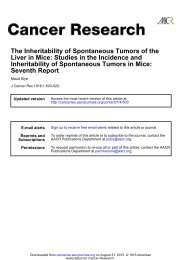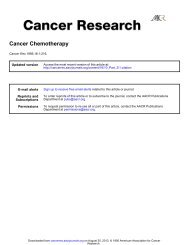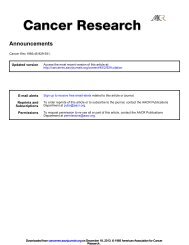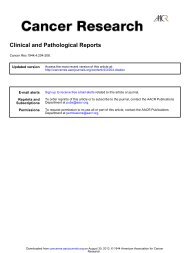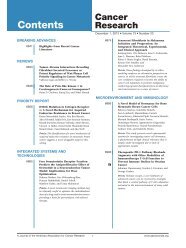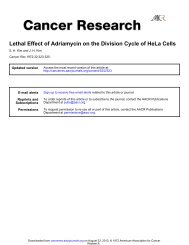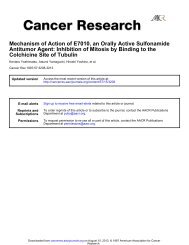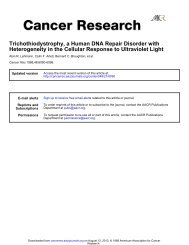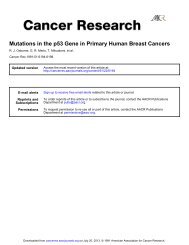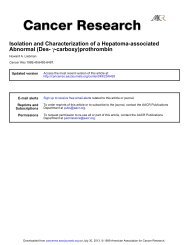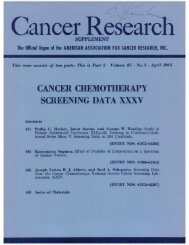Genetic Control of Resistance to Chemically ... - Cancer Research
Genetic Control of Resistance to Chemically ... - Cancer Research
Genetic Control of Resistance to Chemically ... - Cancer Research
You also want an ePaper? Increase the reach of your titles
YUMPU automatically turns print PDFs into web optimized ePapers that Google loves.
assigned; therefore, the mean number <strong>of</strong> mammary adenocarcinomas<br />
per rat for each experimental treatment group could be determined at<br />
various times post-carcinogen exposure. The mean values ±SE for the<br />
mammary adenocarcinomas per animal for each group were determined<br />
by dividing the number <strong>of</strong> new mammary adenocarcinomas observed<br />
within the group in each 10-day interval by the number <strong>of</strong> rats at risk<br />
in that interval and then summing these values by the method <strong>of</strong><br />
McCormick et al. (5). This calculation thus takes in<strong>to</strong> consideration<br />
intercurrent mortality.<br />
Carcinogenic Exposure. For the systemic exposure <strong>to</strong> DMBA, groups<br />
<strong>of</strong> animals were given either a single or multiple doses <strong>of</strong> sesame oil<br />
containing varying amounts <strong>of</strong> DMBA by means <strong>of</strong> gastric intubation<br />
according <strong>to</strong> the method <strong>of</strong> Huggins et al. (15). For the direct in vivo<br />
exposure <strong>of</strong> mammary glands <strong>to</strong> DMBA. the technique <strong>of</strong> Sinha and<br />
Dao (17) was used. This involves anesthetizing rats with Met<strong>of</strong>ane<br />
(Pittman-Moore, Inc., Washing<strong>to</strong>n Crossing, NJ), exposing the right<br />
inguinal mammary gland, dusting 3mg <strong>of</strong> a 2:1 mixture <strong>of</strong> cholesterol<br />
and DMBA (i.e., 1 mg DMBA <strong>to</strong>tal) directly on<strong>to</strong> the exposed gland,<br />
and then closing the skin incision with stainless steel au<strong>to</strong>clips.<br />
For the MNU experiments, groups <strong>of</strong> rats were given either a single<br />
or multiple injections <strong>of</strong> MNU via the femoral vein according <strong>to</strong> the<br />
method <strong>of</strong> Cullino et al. (18). Some rats were also given s.c. injections<br />
<strong>of</strong> a single dose <strong>of</strong> MNU according <strong>to</strong> the method <strong>of</strong> Thompson and<br />
Meeker (19). For i.v. or s.c. injections, MNU was dissolved in 0.85%<br />
NaCl solution adjusted <strong>to</strong> pH 5.0 with 3% acetic acid. DMBA and<br />
MNU were obtained from Sigma Chemical Co. (St. Louis, MO).<br />
RESULTS<br />
DMBA Experiments. When 20 mg <strong>of</strong> DMBA are adminis<br />
tered systemically via a single s<strong>to</strong>mach tube feeding <strong>to</strong> 50-dayold<br />
female SD rats, greater than 90% <strong>of</strong> the animals develop<br />
multiple mammary adenocarcinomas within 1 year (Fig. 1).<br />
Like the randomly outbred SD rat, 50-day-old inbred NSD,<br />
inbred WF, and inbred LEW female rats are all equally highly<br />
susceptible <strong>to</strong> multiple mammary adenocarcinoma development<br />
following DMBA exposure (Fig. 1). Following a single feeding<br />
<strong>of</strong> 20 mg <strong>of</strong> DMBA, female F344 rats are less susceptible <strong>to</strong><br />
development <strong>of</strong> mammary adenocarcinoma and female ACI<br />
rats are even less susceptible (Fig. 1). In direct contrast <strong>to</strong> the<br />
other strains, the mammary glands <strong>of</strong> female COP rats are<br />
resistant <strong>to</strong> p.o. DMBA feeding. None <strong>of</strong> a series <strong>of</strong> twenty five<br />
50-day-old female COP rats fed 20 mg <strong>of</strong> DMBA developed<br />
any detectable mammary adenocarcinomas even if these treated<br />
rats were allowed <strong>to</strong> live for more than 2 years following dosing.<br />
At 50 days <strong>of</strong> age, there are differences in the body weights<br />
3.0!<br />
5O 100 150 200 250 300 350<br />
GENETIC RESISTANCE TO MAMMARY CANCER<br />
FISCHER<br />
Doys Posi DMBA Feeding<br />
Fig. 1. Temporal pattern <strong>of</strong> mammary adenocarcinoma development in var<br />
ious strains <strong>of</strong> female rats following a single p.o. feeding <strong>of</strong> 20 mg <strong>of</strong> DMBA. A<br />
<strong>to</strong>tal <strong>of</strong> twenty-five 50-day-old female rats were dosed for each strain.<br />
between the various strains <strong>of</strong> female rats tested. Since each<br />
strain <strong>of</strong> rat received a single feeding <strong>of</strong> 20 mg <strong>of</strong> DMBA, this<br />
resulted in differences in the dose <strong>of</strong> DMBA (mg/kg body<br />
weight) when normalized on a body weight basis (i.e., SD, 133;<br />
NSD, 133; WF, 160; LEW, 148; F344, 200; ACI, 200; COP,<br />
200 mg). The fact that the high susceptibility SD, NSD, WF,<br />
and LEW strains actually received a lower dose <strong>of</strong> DMBA,<br />
when expressed on a body weight basis, as compared <strong>to</strong> the low<br />
susceptibility F344 and ACI and resistant COP strains, dem<br />
onstrates that the rank order <strong>of</strong> susceptibility or resistance <strong>to</strong><br />
DMBA cannot be trivially explained by differences in body<br />
weights at time <strong>of</strong> carcinogen exposure.<br />
When female SD rats are exposed multiple times <strong>to</strong> p.o.<br />
feeding <strong>of</strong> DMBA, the number <strong>of</strong> mammary adenocarcinomas<br />
induced per rat increases synergistically, not merely additively,<br />
as compared <strong>to</strong> a single dose exposure (20). Therefore, 10<br />
female COP rats were fed 10 mg <strong>of</strong> DMBA 3 times, at weekly<br />
intervals, starting at 36 days <strong>of</strong> life. The animals were followed<br />
for up <strong>to</strong> 1 year <strong>of</strong> life, or until moribund, during which time<br />
no mammary adenocarcinomas developed although 50% <strong>of</strong> the<br />
treated groups did develop leukemia, which was transplantable<br />
by means <strong>of</strong> inoculation <strong>of</strong> donor blood in<strong>to</strong> recipient untreated<br />
COP rats. An additional group <strong>of</strong> 10 COP female rats was fed<br />
5 mg <strong>of</strong> DMBA four times at weekly intervals starting at 36<br />
days <strong>of</strong> life with the same result (i.e., no mammary cancers,<br />
60% incidence <strong>of</strong> leukemia). As a point <strong>of</strong> comparison, NSD<br />
rats given the same 5-mg, four-dose feeding schedule developed<br />
4.0 ±0.5 mammary adenocarcinomas/rat within 200 days.<br />
Since pregnancy commencing after carcinogen exposure has<br />
been shown <strong>to</strong> sharply increase mammary cancer development<br />
and growth in certain strains (21), 20 female COP rats were fed<br />
20 mg <strong>of</strong> DMBA p.o. at 50 days <strong>of</strong> life and then 1 week later<br />
were bred. These animals were allowed <strong>to</strong> deliver their litters<br />
and then were rebred for a minimum <strong>of</strong> four pregnancies. These<br />
animals were followed for over 1 year and only 1 mammary<br />
adenocarcinoma developed in the 20 treated rats (i.e., average<br />
<strong>of</strong> 0.05 ±0.05 mammary adenocarcinomas/rat).<br />
If 1 mg <strong>of</strong> DMBA is directly applied <strong>to</strong> an exposed inguinal<br />
mammary gland <strong>of</strong> SD rat, mammary adenocarcinomas develop<br />
in 100% <strong>of</strong> the directly exposed glands within 200 days but in<br />
0% <strong>of</strong> the unexposed mammary glands <strong>of</strong> the treated hosts<br />
(17). A series <strong>of</strong> inbred rat strains were tested using this direct<br />
application technique. The right inguinal mammary gland <strong>of</strong><br />
10 rats/strain were directly exposed <strong>to</strong> 1 mg <strong>of</strong> DMBA. In the<br />
NSD group, all exposed glands (i.e., 100%) developed mam<br />
mary adenocarcinomas within 200 days; for the WF strain, also<br />
100% incidence; for the F344 strain, 40% incidence; for the<br />
ACI, 25% incidence; and for the COP, 10% incidence <strong>of</strong> mam<br />
mary adenocarcinoma with a 40% incidence <strong>of</strong> fibrosarcoma<br />
formation.<br />
If 50-day-old SD rats are given ¡.p.injections <strong>of</strong> an oil<br />
emulsion containing 5 mg <strong>of</strong> DMBA, all animals develop<br />
mammary adenocarcinomas (22). Therefore, ten 50-day-old<br />
female NSD rats were given injections <strong>of</strong> an oil emulsion <strong>of</strong> 5<br />
mg <strong>of</strong> DMBA and all animals developed mammary adenocar<br />
cinomas (i.e., 1.2 ±0.1 mammary adenocarcinomas/rat) and<br />
one animal (i.e., 10%) developed an abdominal sarcoma. In<br />
contrast, when ten 50-day-old female COP rats were similarly<br />
given i.p. injections <strong>of</strong> DMBA, no animal developed mammary<br />
cancer; however, 40% <strong>of</strong> these COP animals developed i.p.<br />
sarcomas.<br />
MNU Experiments. DMBA is known <strong>to</strong> require metabolic<br />
conversion <strong>to</strong> its ultimate carcinogen (23). The mammary epi<br />
thelial cells <strong>of</strong> female COP rats might be unable <strong>to</strong> properly<br />
3959<br />
Downloaded from<br />
cancerres.aacrjournals.org on February 22, 2013<br />
Copyright © 1986 American Association for <strong>Cancer</strong> <strong>Research</strong>




